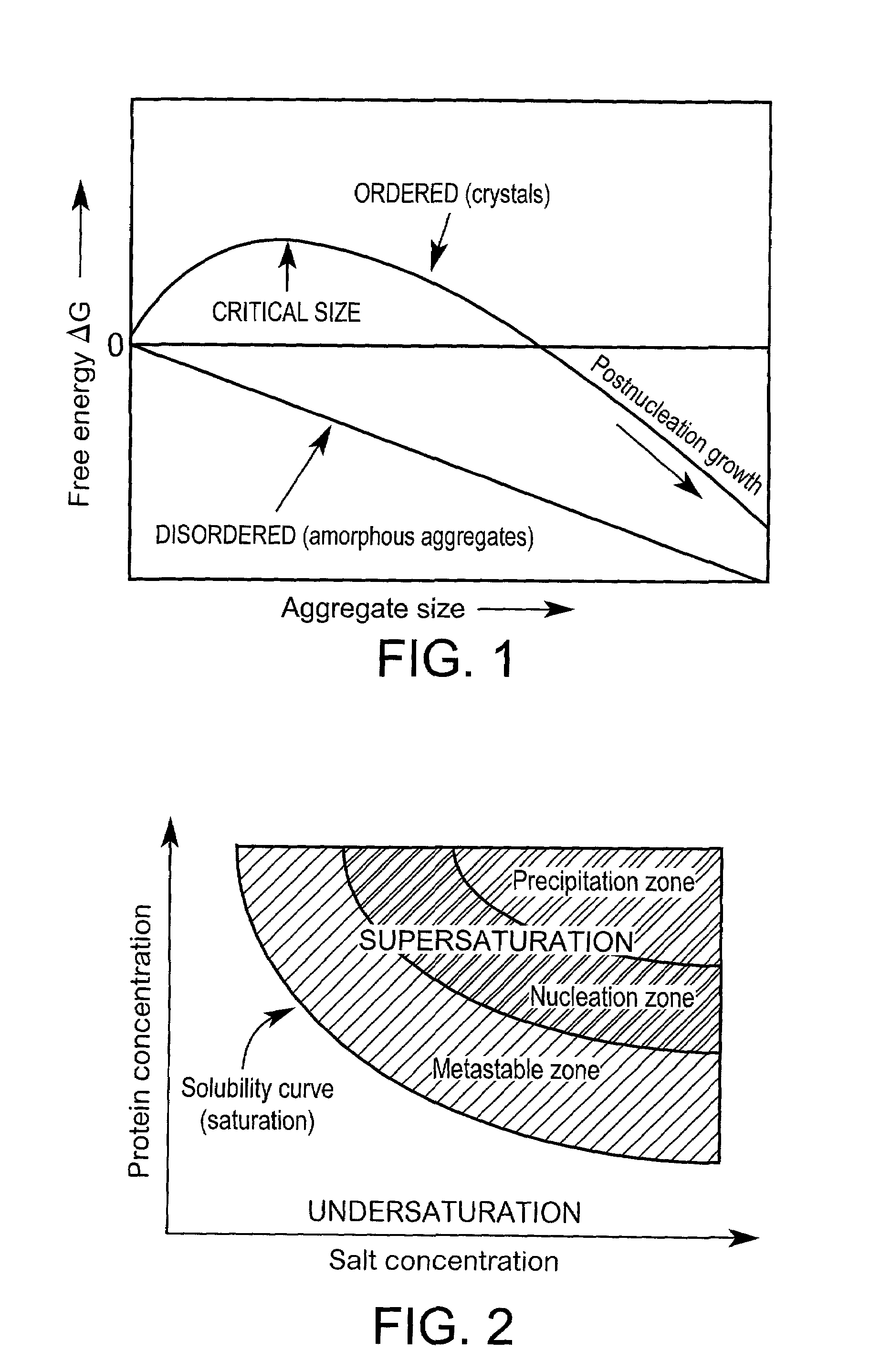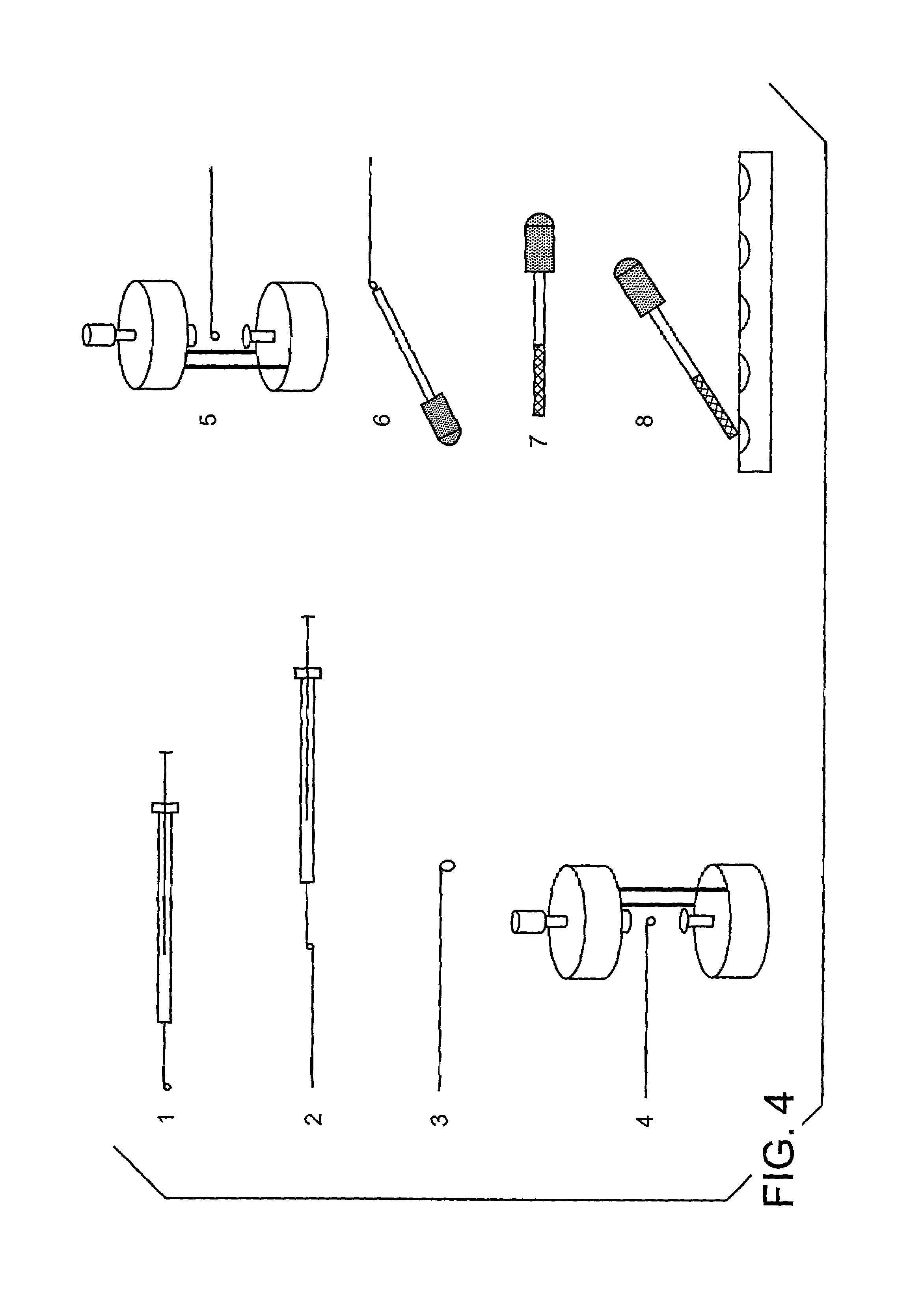Method for screening crystallization or amorphous stage conditions for molecules
a crystallization or amorphous stage technology, applied in the direction of engine components, single crystal growth details, normal temperature solutions, etc., can solve the problems of thermodynamic instability, difficult to obtain suitable crystals, and science has not yet advanced to the level where suitable crystals can be difficult to obtain, and achieve high efficiency, simple
- Summary
- Abstract
- Description
- Claims
- Application Information
AI Technical Summary
Benefits of technology
Problems solved by technology
Method used
Image
Examples
example 1
Partial Phase Diagram Obtained After Screening for Nucleation Using Levitation
Background
[0142]The protein fragment Z1 / Z2 constitutes two domains of the muscle protein titin. The sample was provided by Professor Matthias Willmanns, EMBL, Hamburg, Germany. The theoretical pI-value of the sample was 5.41 and the molecular weight 20689 Da. The sample concentration was ˜60 mg / mL in H2O with a volume of 160 μL totally available. The conditions under which it previously had been crystallised were not known on beforehand. Experiments aimed at determining the boundary between the precipitating zone and the nucleation region in a phase diagram. Ammonium sulphate was constantly used as precipitating agent and the protein concentration ranged between 20–60 mg / mL at neutral pH.
Principle
[0143]Precipitating agents were injected into the levitated droplet using the flow-through picoliter, pl, dispensers (FIG. 5). The precipitant concentration needed to bring the solution to the unstable, supersatur...
example 2
Screening for Nucleation Tendency of E. coli dUTPase Using Video and Framegrabbing
Background
[0159]dUTPases are enzymes regulating the DNA synthesis and are used as targets for drug design. The enzymes have been crystallised earlier and their structures determined (Cedergren-Zeppezauer et al., Nature 355:740 (1992). Dauter et al., Acta Cryst., D54:735 (1998) and Dauter, et al., J. Mol. Biol., 285:655 (1999).
Principle
[0160]The E. coli dUTPase forms crystals readily at pH 4–5, but not at neutral pH or higher. Numerous attempts have failed using protein concentration between 5–10 mg / μl. The nucleation tendency was screened. The system equipped with microscope and video camera was tested using the enzyme E. coli dUTPase.
Experimental Set-up
[0161]The experimental set-up and apparatus is the same as outlined in example 1. Experiments with E. coli dUTPase was performed using the microscope volume evaluation approach as in example 1. Images of a levitated protein solution droplet during diffe...
example 3
Image Series of a Levitated D-serine-dehydratase Drop During a Screening Experiment.
[0168]Materials and methods, experimental setup is identical to the according to the general materials and methods description.
Results
[0169]Image series of a levitated D-serine-dehydratase drop during a screening experiment is shown in FIGS. 11a-f: a, initial protein drop; b, “limit”, first signs of supersaturation; c-e, different stages of supersaturation; and f, total precipitation of protein. The differences in drop shape and size are due to variations of the drop volume during additions and / or evaporation. The images were recorded using 6.3× magnification. A picture was recorded every 30–60 seconds, and about 6 recordings were made. The total experimental time was 10 minutes.
PUM
| Property | Measurement | Unit |
|---|---|---|
| Length | aaaaa | aaaaa |
| Length | aaaaa | aaaaa |
| Density | aaaaa | aaaaa |
Abstract
Description
Claims
Application Information
 Login to View More
Login to View More - R&D
- Intellectual Property
- Life Sciences
- Materials
- Tech Scout
- Unparalleled Data Quality
- Higher Quality Content
- 60% Fewer Hallucinations
Browse by: Latest US Patents, China's latest patents, Technical Efficacy Thesaurus, Application Domain, Technology Topic, Popular Technical Reports.
© 2025 PatSnap. All rights reserved.Legal|Privacy policy|Modern Slavery Act Transparency Statement|Sitemap|About US| Contact US: help@patsnap.com



